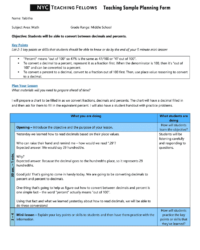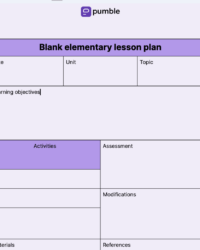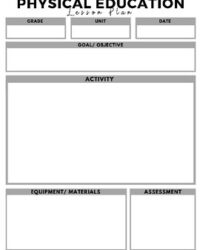Teaching can often feel like a whirlwind, especially when you’re juggling multiple subjects, diverse student needs, and ever-changing schedules. It’s easy to get caught up in the day-to-day demands and forget the power of thoughtful, pre-emptive planning. Yet, effective planning is the cornerstone of successful instruction, allowing you to walk into any classroom feeling prepared and confident, ready to engage your students.
That’s where a well-designed short term lesson plan template comes in. It’s not about rigid adherence to a script, but rather a flexible framework that guides your thinking, ensures all essential elements are covered, and frees up your mental energy for the actual act of teaching. Think of it as your reliable roadmap for daily or weekly lessons, keeping you on track without feeling overwhelmed.
Why a Short Term Lesson Plan Template is Your Teaching Superpower
In the fast-paced world of education, time is a precious commodity. Crafting detailed, multi-page lesson plans for every single class can be an exhausting endeavor, often leading to burnout or rushed, ineffective sessions. A short term lesson plan template, however, cuts through the noise, allowing you to focus on the core objectives and activities for a specific period, be it a single class, a day, or even a few days. It provides a quick, visual overview of what needs to happen, who it’s for, and how you’ll know if it’s successful.
Beyond saving time, these templates bring an incredible sense of clarity and focus to your teaching. They compel you to distill your lesson down to its most crucial components, ensuring that every activity serves a purpose and aligns directly with your learning goals. This streamlined approach minimizes tangents and maximizes instructional efficiency, which ultimately benefits your students by providing a clear, coherent learning experience. It also makes it easier to adapt on the fly, as you have a clear understanding of your core plan to which you can always return.
Moreover, having a consistent template promotes better organization and reduces mental clutter. Instead of reinventing the wheel for every lesson, you have a familiar structure to fill in, allowing you to concentrate on the creative aspects of lesson design, such as finding engaging activities or innovative ways to explain complex concepts. This consistency also aids in self-reflection and improvement; by using the same format, you can easily compare past lessons, identify what worked well, and pinpoint areas for adjustment.
Ultimately, a robust short term lesson plan template empowers you to deliver high-quality instruction consistently, reduce planning stress, and create more impactful learning experiences for your students. It’s not just a document; it’s a tool for greater teaching effectiveness and personal well-being.
Key Components of an Effective Short Term Lesson Plan Template
* **Lesson Title/Topic:** A concise name for your lesson.
* **Date/Time/Class:** Specific details for scheduling and identification.
* **Learning Objectives:** What students should know or be able to do by the end of the lesson (SMART goals are best).
* **Materials/Resources:** Everything you’ll need (whiteboard, markers, handouts, tech, etc.).
* **Procedure/Activities:** A step-by-step outline of how the lesson will unfold (introduction, main activities, guided practice, independent practice).
* **Differentiation/Support:** How you’ll address varied student needs (scaffolding, extensions, accommodations).
* **Assessment:** How you’ll check for understanding and evaluate learning (informal checks, exit tickets, quick quizzes).
* **Homework/Next Steps:** Any assignments or preparations for the next lesson.
Tips for Customizing Your Template
Don’t be afraid to make a template your own. Add sections relevant to your specific subject or teaching style, such as a “parking lot” for student questions or a space for post-lesson reflections. The goal is for it to be a genuinely useful tool for *you*.
Building Your Go-To Short Term Lesson Plan Template
Creating a short term lesson plan template that truly works for you is an iterative process, much like teaching itself. You don’t need to start from scratch. Many pre-existing templates are available online, but the key is to adapt or build one that resonates with your personal planning style and the unique demands of your classroom environment. Think about the core information you consistently need to jot down before any lesson. What helps you feel prepared? What ensures you don’t miss a crucial step?
Consider starting with the essentials, such as learning objectives and key activities, and then gradually add more sections as you identify needs. For instance, if you often forget to prepare specific materials, add a dedicated "Materials" section. If you struggle with time management during lessons, incorporate a "Time Allotment" column next to each activity. The beauty of a template is its flexibility; it’s a living document that can evolve alongside your teaching practice.
Once you have a working draft, try it out for a week or two. After each lesson, take a moment to reflect. Was the template easy to use? Did it help you stay organized? Were there any missing sections that would have been helpful, or any unnecessary ones that just added clutter? Don’t be afraid to make tweaks and adjustments based on your real-world experience. The most effective template will be the one that you find intuitive, comprehensive enough for your needs, and genuinely helpful in streamlining your planning process.
- Identify your core planning needs: What information is essential for every lesson you teach?
- Start simple: Don’t overload your template with too many sections initially.
- Use clear headings: Make sure each section is easily identifiable.
- Incorporate checklists: Checkboxes for materials or completed tasks can be incredibly helpful.
- Leave space for notes: A section for reflections or future adjustments is invaluable.
- Keep it concise: The “short term” aspect means it should be quick to fill and easy to scan.
- Test and refine: Use your template for a few lessons, then adjust based on your experience.
Embracing the use of a practical lesson planning tool can profoundly transform your daily teaching life. It moves you from reactive, last-minute preparations to proactive, confident instruction, allowing you to dedicate more energy to student interaction and less to frantic organization. This strategic approach ensures every moment in the classroom is purposeful and productive.
By consistently utilizing a well-structured framework, you’ll not only save precious time but also elevate the quality of your lessons. It’s a small investment in preparation that yields significant dividends in terms of clarity, student engagement, and your overall peace of mind as an educator. Make it a foundational part of your teaching toolkit, and watch your planning become simpler and more effective.


